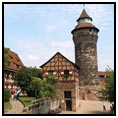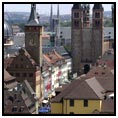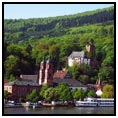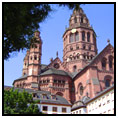A Special Trip this Fall
Cruise Itinerary
Day 1 - Nuremberg
The second largest city in Bavaria, Nuremburg is filled with gothic churches and traditional half-timbered houses. Although nearly destroyed during World War II, the protective city walls still feature some of the ancient moats, tall watchtowers and grand gateways. Nuremberg was long known for its metal and toy craftsmanship, and the city's modern historical significance can be traced to its role as the location for the post-World War II war crimes trials of the Nazis at the Palace of Justice. These trials were immortalized in the 1961 film, Judgment at Nuremberg. Read More
Day 2 - Bamberg
Described as probably Germany´s most beautiful city, Bamberg offers a treasure trove of Germany´s finest art and examples of Europe´s greatest architecture styles - Romanesque, Gothic, Renaissance and Baroque. Founded in 902, Bamberg remains a medieval-looking city known for its symphony orchestra and specialty "smoke" beer. Bamberg was also the first site in Germany of lithographic printing featuring movable type. The city's winding streets are filled with baroque patrician houses as well as the breathtaking 11th century cathedral of Holy Roman Emperor Heinrich II, which houses his tomb as well as that of Pope Clement II. Tour the 16th century Alt Residenz (Old Residence) and the 17th century Neue Residenz (New Residence), both of which were bishop's houses. Read More
Day 3 - Wurzburg
Surrounded by Franconian vineyards, Wurzburg was heavily damaged during World War II, but has since been completely restored. Here is Germany's most pristine example of baroque architecture, the great Residenz, built in 1744 by the Prinz-Bishops. Its sweeping staircase and amazing ceiling frescos by Tiepolo survived wartime bombs. Other landmarks include the medieval statue-lined Main Bridge and the Marienberg fortress, originally a Celtic hill fort and later residence of the bishops. The round 8th century church within the courtyard of the fortress is one of Germany's oldest churches. Read More
Day 4 - Miltenberg
A quaint Bavarian village, Miltenberg began as a Roman fort on the Main. The Gothic grandeur of its Merchant Hall and many Medieval and Renaissance houses reflect its affluence and cultural wealth. Enticing outdoor cafes, half-timbered houses and a 400-year-old fountain are among the memorable sights you'll see in Market Square. Read More
Day 5 - Mainz
Located in the heart of the Rhine wine region, Mainz has played many historic roles. Due to its favorable location on the mouth of the Main River and being close to the mouth of the Nahe River, Mainz gained economic and political strength. Under Roman rule, it served a key part of the Roman Empire's northern defenses and during the Middle Ages, it served as a major trade center. Later, Mainz became home to printing pioneer Johannes Guttenberg. Read More
Day 6 - Cochem
Following the course of the Moselle river for more than 100 miles is the beautiful Moselle Valley. The prettiest town in this popular wine-producing region, Cochem occupies the site of one of the valley´s earliest settlements. The medieval-style Reichsburh Castle, which dominates the town from atop a hill, is worth seeing, as is the Old Town with its cobblestone streets and halftimbered houses. Read More
Day 7 - Bernkastel
A well known wine growing centre situated on the Mosel River. In the centre is the Market surrounded by color-washed half-timbered houses and the remains of medieval walls including the Ender Gate built in 1332. The well-restored castle which looms above the town was severely damaged in 1689 during the "Orleans War" of 1688-97. Read More







